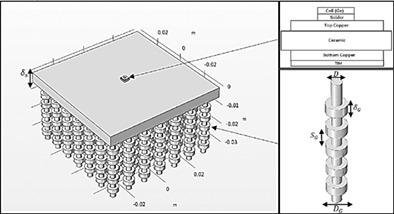当前位置:
X-MOL 学术
›
Int. J. Energy Res.
›
论文详情
Our official English website, www.x-mol.net, welcomes your
feedback! (Note: you will need to create a separate account there.)
A comprehensive study of pin fins cooling channel for a single‐cell concentration photovoltaic system under ultra‐high concentration ratios
International Journal of Energy Research ( IF 4.3 ) Pub Date : 2020-10-27 , DOI: 10.1002/er.6126
Taher S. Maatallah 1
International Journal of Energy Research ( IF 4.3 ) Pub Date : 2020-10-27 , DOI: 10.1002/er.6126
Taher S. Maatallah 1
Affiliation

|
Analysis of the single‐cell concentration photovoltaic (CPV) system is challenging due to the high thermal stress across the solar cell surface area inducing extreme degradation of the electro‐mechanical behavior. Although the good thermal performance shown by the passive cooling using heat sinks and the different optical configurations based on Cassegrain and Fresnel lens designs, the experimentally achieved concentration ratio (CR) is still below 5800 suns. The actively cooled heat sink integrating millimeter‐scale pin‐fin array inside a cooling channel can be promising toward minimum heat sink weight and maximum discharge of the generated heat. The current study presents a comprehensive analysis of a pin‐fins cooling channel for a single‐cell CPV system under ultra‐high CRs. The thermal performance and the hydraulic resistance of five pin‐fin heat‐sink configurations were performed at different CRs and low Reynolds number for an Aluminum substrate material. The inline pin‐fins heat sink (PFHS) displayed the minimum average cell temperature for all Reynolds numbers with thermal performance higher than its closest successor by 9.07%. The thermal performance and the pressure drop showed more dependence on streamwise spacing rather than spanwise spacing for all tested staggered pin‐fin heat sinks. Pressure drop drastically increased at higher Reynolds number, Re = 726, for the inline pin‐fin heat sink reaching a value of 288.20 Pa due to higher disturbance in the streamwise direction. The results demonstrate that the inline pins‐fin heat sink with a constant distribution of circular axial grooves (plugs) along each pin can keep the solar cell within a safe operating temperature, that is, 80°C, for CR up to 15 000 suns at an ambient temperature below or equal to 35°C.
中文翻译:

超高聚光比下单池聚光光伏系统针翅冷却通道的综合研究
由于太阳能电池表面积上的高热应力会导致机电性能的极端下降,因此对单电池集中式光伏(CPV)系统的分析具有挑战性。尽管使用散热器进行被动冷却以及基于卡塞格伦和菲涅耳透镜设计的不同光学配置显示出良好的热性能,但实验获得的浓度比(CR)仍低于5800太阳。主动冷却的散热器在冷却通道内部集成了毫米级的针鳍阵列,有望实现最小的散热器重量和最大的散热量。本研究对超高CR下单电池CPV系统的针翅冷却通道进行了全面分析。对于铝基板材料,在不同的CR和低雷诺数下,执行了五种针翅式散热器配置的热性能和水力阻力。直插式翅片散热器(PFHS)显示所有雷诺数的最低平均电池温度,其热性能比其最接近的后继产品高9.07%。对于所有测试的交错式针翅式散热器,热性能和压降显示出更多的依赖于流向间距,而不是跨度间距。雷诺数越高,压降急剧增加,直插式翅片散热器(PFHS)显示所有雷诺数的最低平均电池温度,其热性能比其最接近的后继产品高9.07%。对于所有测试的交错式针翅式散热器,热性能和压降显示出更多的依赖于流向间距,而不是跨度间距。雷诺数越高,压降急剧增加,直插式翅片散热器(PFHS)显示所有雷诺数的最低平均电池温度,其热性能比其最接近的后继产品高9.07%。对于所有测试的交错式针翅式散热器,热性能和压降显示出更多的依赖于流向间距,而不是跨度间距。雷诺数越高,压降急剧增加,Re = 726,因为流向方向上的扰动较大,直插式针翅式散热器达到288.20 Pa的值。结果表明,直插式引脚翅片散热器沿每个引脚都具有恒定的圆形轴向凹槽(塞子)分布,可以将太阳能电池保持在80°C的安全工作温度范围内,CR可达15000个太阳在低于或等于35°C的环境温度下。
更新日期:2020-10-27
中文翻译:

超高聚光比下单池聚光光伏系统针翅冷却通道的综合研究
由于太阳能电池表面积上的高热应力会导致机电性能的极端下降,因此对单电池集中式光伏(CPV)系统的分析具有挑战性。尽管使用散热器进行被动冷却以及基于卡塞格伦和菲涅耳透镜设计的不同光学配置显示出良好的热性能,但实验获得的浓度比(CR)仍低于5800太阳。主动冷却的散热器在冷却通道内部集成了毫米级的针鳍阵列,有望实现最小的散热器重量和最大的散热量。本研究对超高CR下单电池CPV系统的针翅冷却通道进行了全面分析。对于铝基板材料,在不同的CR和低雷诺数下,执行了五种针翅式散热器配置的热性能和水力阻力。直插式翅片散热器(PFHS)显示所有雷诺数的最低平均电池温度,其热性能比其最接近的后继产品高9.07%。对于所有测试的交错式针翅式散热器,热性能和压降显示出更多的依赖于流向间距,而不是跨度间距。雷诺数越高,压降急剧增加,直插式翅片散热器(PFHS)显示所有雷诺数的最低平均电池温度,其热性能比其最接近的后继产品高9.07%。对于所有测试的交错式针翅式散热器,热性能和压降显示出更多的依赖于流向间距,而不是跨度间距。雷诺数越高,压降急剧增加,直插式翅片散热器(PFHS)显示所有雷诺数的最低平均电池温度,其热性能比其最接近的后继产品高9.07%。对于所有测试的交错式针翅式散热器,热性能和压降显示出更多的依赖于流向间距,而不是跨度间距。雷诺数越高,压降急剧增加,Re = 726,因为流向方向上的扰动较大,直插式针翅式散热器达到288.20 Pa的值。结果表明,直插式引脚翅片散热器沿每个引脚都具有恒定的圆形轴向凹槽(塞子)分布,可以将太阳能电池保持在80°C的安全工作温度范围内,CR可达15000个太阳在低于或等于35°C的环境温度下。































 京公网安备 11010802027423号
京公网安备 11010802027423号